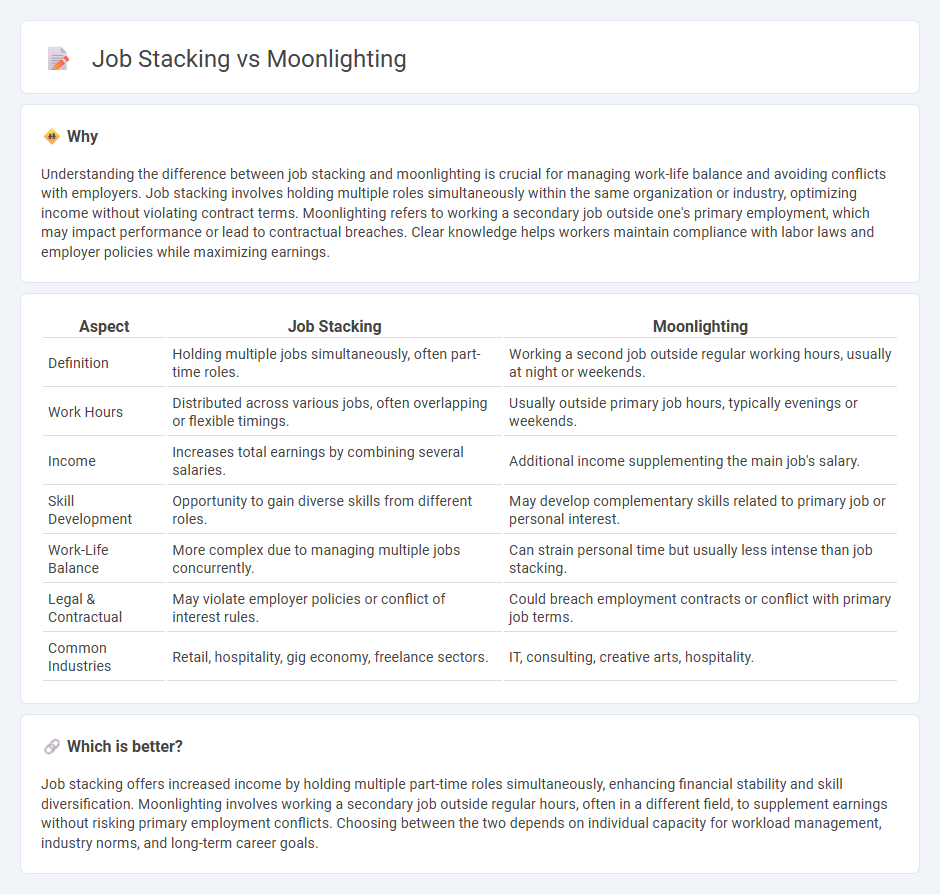
Job stacking involves holding multiple part-time positions simultaneously to increase total income without overlapping hours, while moonlighting refers to working a second job outside regular working hours, often after a full-time role. Both methods can enhance earning potential but require effective time management and clear communication with employers. Explore the differences and benefits of job stacking and moonlighting to determine the best fit for your career goals.
Why it is important
Understanding the difference between job stacking and moonlighting is crucial for managing work-life balance and avoiding conflicts with employers. Job stacking involves holding multiple roles simultaneously within the same organization or industry, optimizing income without violating contract terms. Moonlighting refers to working a secondary job outside one's primary employment, which may impact performance or lead to contractual breaches. Clear knowledge helps workers maintain compliance with labor laws and employer policies while maximizing earnings.
Comparison Table
| Aspect | Job Stacking | Moonlighting |
|---|---|---|
| Definition | Holding multiple jobs simultaneously, often part-time roles. | Working a second job outside regular working hours, usually at night or weekends. |
| Work Hours | Distributed across various jobs, often overlapping or flexible timings. | Usually outside primary job hours, typically evenings or weekends. |
| Income | Increases total earnings by combining several salaries. | Additional income supplementing the main job's salary. |
| Skill Development | Opportunity to gain diverse skills from different roles. | May develop complementary skills related to primary job or personal interest. |
| Work-Life Balance | More complex due to managing multiple jobs concurrently. | Can strain personal time but usually less intense than job stacking. |
| Legal & Contractual | May violate employer policies or conflict of interest rules. | Could breach employment contracts or conflict with primary job terms. |
| Common Industries | Retail, hospitality, gig economy, freelance sectors. | IT, consulting, creative arts, hospitality. |
Which is better?
Job stacking offers increased income by holding multiple part-time roles simultaneously, enhancing financial stability and skill diversification. Moonlighting involves working a secondary job outside regular hours, often in a different field, to supplement earnings without risking primary employment conflicts. Choosing between the two depends on individual capacity for workload management, industry norms, and long-term career goals.
Connection
Job stacking and moonlighting both involve holding multiple jobs simultaneously to increase income and leverage varied skill sets. Job stacking refers to managing two or more jobs with flexible hours, often remote, while moonlighting typically means working a secondary, part-time job outside regular working hours. Both practices reflect a growing trend toward diversified employment strategies in the gig economy and freelance markets.
Key Terms
Dual Employment
Moonlighting involves holding a secondary job outside of primary employment, often in a different industry or role, allowing individuals to supplement income or pursue passions. Job stacking refers to simultaneously managing multiple part-time or freelance roles within similar or complementary fields, maximizing productivity and earnings through flexible scheduling. Explore comprehensive strategies and legal considerations for dual employment to optimize time and income effectively.
Conflict of Interest
Moonlighting involves holding a secondary job outside normal working hours, which may lead to conflicts of interest when the side job competes with or undermines the primary employer's business. Job stacking refers to simultaneously managing multiple full-time roles, heightening the risk of conflicting duties, intellectual property issues, and divided loyalties. Explore more about mitigating conflicts of interest in dual employment scenarios for better career management.
Work-life Balance
Moonlighting involves taking on a second job outside regular working hours, often leading to challenges in maintaining work-life balance due to extended work commitments. Job stacking refers to simultaneously holding multiple part-time jobs, which can create a complex schedule and increase stress if not managed carefully. Explore strategies to balance multiple employments for improved personal well-being and productivity.
Source and External Links
MOONLIGHTING definition | Cambridge English Dictionary - Moonlighting refers to the act of working at an extra job, often without telling one's main employer.
Moonlighting (TV series) - This American comedy-drama series aired on ABC from 1985 to 1989, starring Cybill Shepherd and Bruce Willis as private detectives.
Moonlighting | Wex | US Law - Moonlighting involves working more than one job at a time, often outside normal working hours, and can be subject to employer policies.
 dowidth.com
dowidth.com